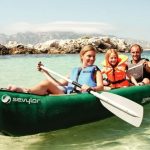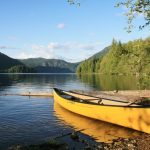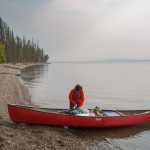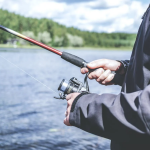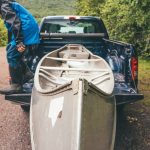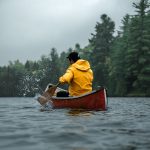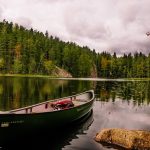Inflatable canoes are easy to transport and store. Here is our list of the best inflatable models to help you make the right choice.
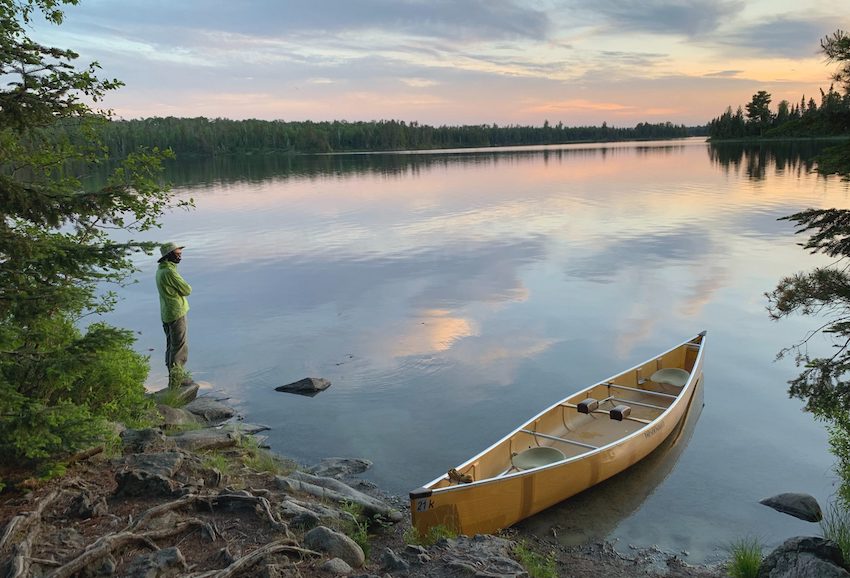
In the past ten years, I have been out on almost one hundred camping trips on the water, both here in Scotland and around Europe. These have ranged from short overnighters to eight day epics, some in my own time with friends, others guiding clients into a whole new world of canoe camping.
In that time I have learned countless lessons along the way, often the hard way. From hunkering down under a canoe for a cold night in the rain, to eating dried oatmeal and cold coffee for breakfast when my stove died, I’ve been there. This guide is a cumulation of tips, hints, and ideas that I have picked up along the way that will help you prepare for your canoe camping trip.
Pre-Trip Planning

There’s plenty to be done before you even think about loading your canoe up on the rooftop and heading out onto the water. Sit down with a cold one, or a hot one depending on your preference, and make sure you have everything planned to make your trip a success.
How Much Time Have You Got?
The length of your canoe trip is often dictated by how much time you have off work. It’s surprising how much you can fit into a weekend though, especially if you’re packed and ready to go when you finish work on a Friday night. Short trips can be a down and dirty, fast and light style trip where you don’t have to load up on masses of gear to make things work.
Though discomfort is bearable for the occasional night, on longer canoe trips you will usually want to carry more gear. Of course, you will need more food, but you’re also likely to want some of the creature comforts you would have at home. Perhaps charging blocks, pillows, and a more substantial tent might be in order when you’re heading out for a week.
How Far Can You Paddle in a Day?
The average canoeist will paddle at around 2 – 3 mph. This means that by paddling for 8 hours, you can cover 16 – 24 miles in a day. But not all canoes, or canoeists, are created equal.
It’s useful to learn how far you can reasonably paddle in a day and how long you can paddle for. You might top out at 10 miles or can go for 30. Knowing this will allow you to plan a trip that is right for you.
Remember that your pace and distance will also vary dependent on wind conditions, river levels, and even the rain. In cold and wet conditions, it can be hard to get motivated, while in hot weather you may struggle to exert yourself for hours at a time. Plan cautiously and don’t anticipate covering great distances until you’re sure you’re ready for them.
Pick a trip
It’s time to break out the maps, trawl through the guidebooks, and search the internet to find a trip. Trips come in all different styles and if you’re heading somewhere new it can be a great idea to phone an outfitter in the area – after all, local knowledge is almost always the best.
Pick a trip that is suitable to your timeframe, but also your paddling style, as well as the paddling level of everyone in the group. A remote rapid three days into the trip and hours from help is not a time to push your skills, so stick to what you’re comfortable with.
Know the Route
Once you’ve read the reports or phoned the outfitter, keep researching your chosen trip. This is especially important if you’re heading somewhere remote, or to a location brand new to you. The more you know about the trip, the less likely you are to make a navigational error.
Maps can be left out on coffee tables for days or weeks and checked routinely until you know every turn along the way. You can even make notes on the map, or on a separate notebook, for bearings, portages, or notable features like large rapids along the way. This goes a long way to limiting mistakes and helps to put you more at ease once you’re out on the trip.
RELATED: Kayaking Near Me: the Interactive Map of Places to Go Paddling
Check for any facilities along the route, too. These could be towns that you can stay in or restock food supplies in, or simply water supply points and a shelter you can use for the night. It’s also a good idea at this stage to check whether you need a permit to paddle where you want to go.
Check the weather forecast
Ideally, all of our canoe trips would happen under a bright blue sky, with a gentle breeze to help us along and keep the bugs at bay. The reality is that nature is rarely so kind to us, but this makes those trips all the more special.
The elements are not to be messed about with. Check the weather before you go and decide on whether you need to make any changes to your trip to accommodate the forecast. Are there rivers that are going to come into a flood, or perhaps a strong wind that will force you off the lake?
If the weather looks really nasty, you might have to completely change where you’re going. At other times, you can get away with minor route changes, or beat the weather by setting off earlier and having a mid-afternoon finish. If you’re not sure that you’re going to have a cell phone signal out on your trip, take the forecast with you.
Transportation
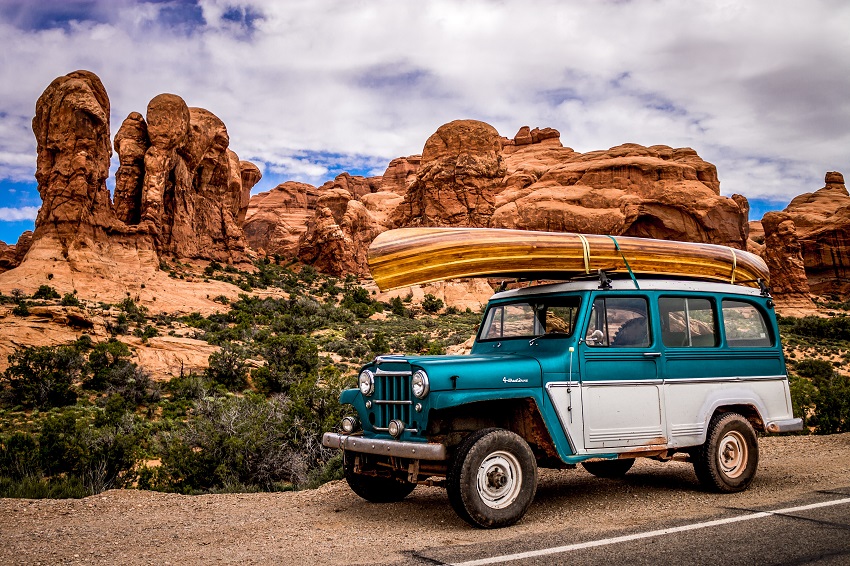
Getting your canoe and all of your gear to the water is the first step of your trip. If your trip is an out-and-back or a circular route, you can often get away with just one vehicle that is parked at the start of the trip. If you are canoeing a linear trip, you will need to leave a vehicle at the end or organize a shuttle service.
A lot of local outfitters offer shuttle services for you and your gear and this can relieve a lot of stress from your trip. Failing that, you can leave a second vehicle at the end to load up and return, or book a taxi and then go back to collect your gear. Where possible, leave someone with the gear while the shuttle is happening, that way you’ll still have a canoe to come back to.
Top tip: Keeping your key on your person at all times means that even if you lose gear, you can always make it home at the end of your trip. Secure it in a waterproof pouch or container and keep it in your PFD pocket.
Have a Plan B
And C, D, and perhaps even an E. Most trips make it a long way through the alphabet by the end of their trip. Sure, you might stick to your plan A, but it’s always a good idea to know your options.
Check out where you can get out if things are going wrong, where you might have a cell signal, and any roads or towns along the way. On the trip, be ready to change it up if you’re not paddling how you had planned, or if things look a little different from how they were described in the guidebook. These usually aren’t big changes, but perhaps camping a few miles short of where you had planned, or in a spot with some shelter from the wind for example.
Assign Home Contacts
Sure, we all have cell phones nowadays and unless we’re a long way into the wilderness we can usually rely on having a signal. But what about if you lose your phone, or it gets wet and dies? A home contact can phone the authorities on your behalf if they do not hear from you after an allotted time and this has saved lives in the past.
These home contacts should know your plan, location, and details of vehicles and outfitters you plan to use. The more information these home contacts can give to the authorities – canoe type, color, tent style – the more likely they are to find you.
Agree on a time that you should be in touch with your home contact, and an emergency time that they should alert the authorities if they haven’t heard from you. On shorter trips, this might just be an hour, while on longer trips it may be days, to account for a potential lack of phone signal.
What’s the Best Canoe for Camping?

The best canoe for canoe camping or tripping will depend on the style of your trip. Picking the right canoe is imperative to success and comfort, so here are the three main elements to help you choose.
Dimensions
The key dimensions of a canoe are length and width. Longer canoes are faster and track more effectively against the wind than shorter canoes, making them a better choice if you have long distances to cover. Shorter canoes are more maneuverable and better suited to river trips or shorter journeys where you need to turn in tight spots.
Wide canoes have a higher level of primary stability, making them more stable when they’re flat or stationary. This width creates drag on the water and slows the canoe down though, so narrower canoes are often chosen on longer journeys. Wider canoes are suited to family trips or journeys where you are carrying heavy loads.
Capacity
How much weight you can load into your canoes will directly affect the gear you can take with you. When you’re looking at your overall weight, remember to include the weight of all paddlers, their clothing, as well as any gear and equipment being taken onboard. You should keep your loaded weight to less than 70% of the overall capacity of the canoe for optimal performance.
Weight
The lighter your canoe, the easier it is to carry and the less you have to exert yourself. Lightweight canoes are ideal for trips with portages, but also remember you’re going to have to propel yourself across the water for days at a time. Heavy canoes might not make a difference on the first stroke, but by the thousandth, you could be feeling it.
There are advantages to heavier canoes though. For a start, they’re often far cheaper than their lightweight alternatives, making canoe camping more accessible. They also tend to be stronger and better suited to rocky rivers and rough water environments that can damage a canoe.
Canoe trippers will often try to strike a balance of weight and strength which means they won’t be struggling along portage trails but also aren’t going to have to carry out running repairs every few hours.
What to Wear on the Water
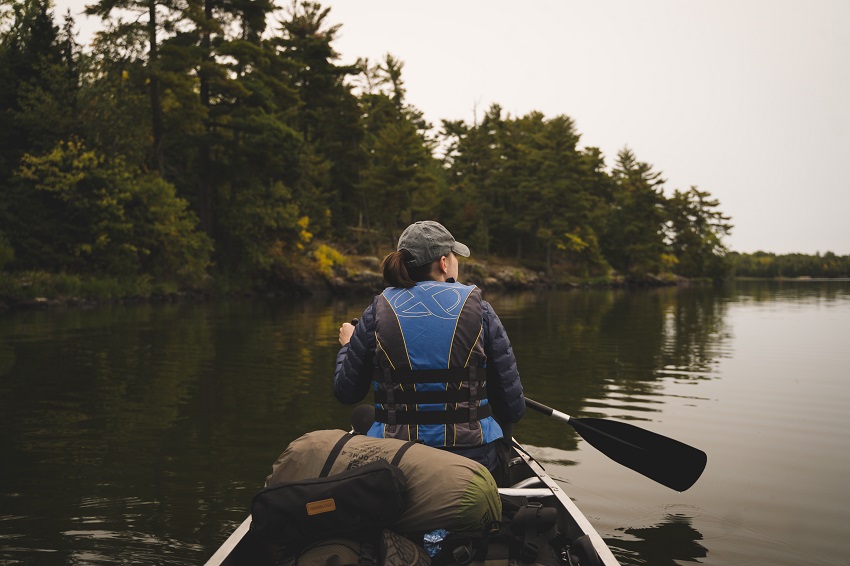
PFD
You should always wear a PFD on the water. There are different styles of PFD, but most canoe campers or trippers will be comfortable in a recreational PFD. Specialist touring or white water life jackets might be suitable for some longer trips and will have specialist safety features, as well as more pockets for snacks and equipment.
Dress for the Weather
There are days for canoeing in a swimsuit and PFD and other days where you need to be loaded up with warm clothing and waterproof outers. Dress for the weather, remembering that you should be always prepared to get wet, just in case.
In general, it’s a good idea to prioritize layers over bulkier clothing. Layers keep you warmer and are also easier to change throughout the day if you need to warm up or cool off. In warmer weather, UV protective layers and sunscreen are essential.
ALSO SEE: What to Wear While Kayaking: The Ultimate Dress Code for Paddlers
Footwear
We always recommend wearing secure footwear. You never know what’s lurking on the river or lake bed and when you might need to move around quickly on the shore.
Neoprene kayaking boots are often a great choice but can be too hot on long trips and lack grip for portages. More technical paddling boots are usually a better choice for long trips. Sandals are a great way to let your feet breathe on the water, but aren’t always great on the portage trail.
Hats and Helmets
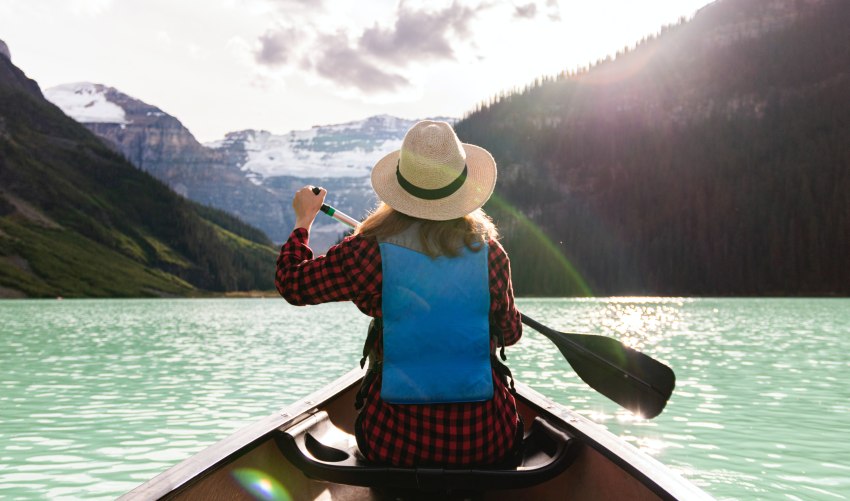
Whether you need to take a helmet with you on your trip will depend on the environment but it would be unusual to head out on a canoe trip without a hat of some kind. Whether it’s a winter hat to keep you warm or protect you from strong winds, or a sun hat to stop you from overheating, these are essential for canoe camping.
If your trip takes you down a river that contains rapids, you might find yourself wearing a helmet intermittently. In this case, you can stuff your hat down the back of your PFD while wearing your helmet, then retrieve it once you are safely through the rougher spots. Don’t forget to secure your helmet to your canoe to avoid losing it.
Packing for Canoe Camping

Packing Your Gear: Dry Bags vs. Barrels
It’s important that you keep your canoe camping gear dry and secure while you’re on the water, but also in the event that you end up in the water. Most canoeists achieve this using either dry bags or barrels.
Barrels are popular among canoeists for their robustness and longevity. These barrels rely on a sealed lid, secured with a clip to keep it in place, and are capable of keeping your gear dry even while bouncing down a river. Barrel harnesses can be added for carrying these on longer portages, so you don’t have to make extra trips.
Dry bags can be more comfortable to carry on longer portages and have the added bonus that they can be compressed when they’re not full, freeing up space in your canoe. Heavy-duty PVC dry bags are usually the best option as they are more durable and have a higher waterproof rating.
However you load your equipment, prioritize keeping important gear like sleeping bags and spare layers dry. Packing into smaller dry bags inside your barrel or bag can make it easier to find equipment and prevents it from getting soaked if your outer protection fails.
Pack a Day Bag or Barrel
Where possible, you want to avoid opening your main bag or barrel throughout the day. The more times you open it, the greater the chance is that you don’t properly secure the lid or straps. If your bag or barrel is tied into your canoe, you will end up wasting a load of time freeing it when you need access.
A small day dry bag or barrel for snacks and those things you need to keep close at hand is a useful addition to your canoe. This can be secured more loosely to the boat and shouldn’t contain any major essentials, but is a great place to keep snacks and spare layers.
Packing Food and Fuel
You’re going to need to eat plenty of food out on your canoe camping trip. One of the beauties of canoe camping is that you don’t have to scrimp on your meals. Sure, if you’re out for multiple weeks you might choose to eat energy bars and freeze-dried meals to save on weight. But if you’re going out on a shorter trip, you can cook anything, from steaks to stews.
Prepare as much food as is reasonable before you go, including chopping and packaging food that is going to be used on the first or second night. You can even make chili or similar to heat up when you get into camp and save time on the trail. How you cook is up to you and there are loads of canoe camping books and videos that show you meals for on the trail.
Cooking can be done using stoves, barbeques, dutch ovens, or any other method that works for you. If you’re carrying fuel, keep it separate from your clothes and sleeping bag in case of leaks. If you plan to cook on open fires or with a flame, be sure to check local guidelines and advice on wildfires and wood collection and abide by them. This may mean carrying in all of your wood or coals and loading the ashes back out with you too.
Emergency Extras
A few well-chosen extras, both gear and food, should be stashed in your main barrel or bag. Ideally, you won’t need these at any time, but should you capsize, or find yourself shore-bound for an entire day, they may be enough to keep you comfortable.
Gear List
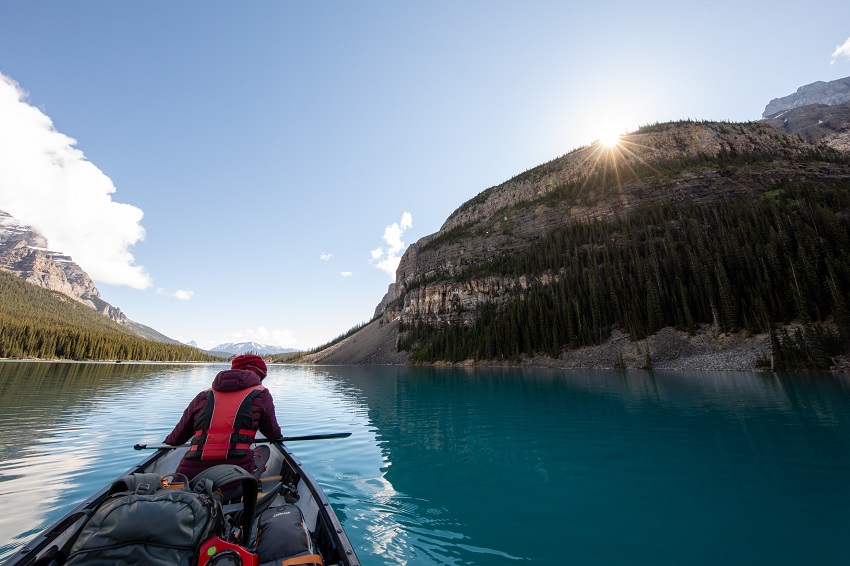
This gear list is not exhaustive and can be altered, but can help you to pack for your first trip. It’s a good idea to put together a list for each trip that you can tick off as you pack to prevent any surprises when you reach camp.
Paddling Items
- Canoe
- Paddles (One per paddler + spare)
- Personal clothing + PFD
- Waterproof jacket and pants
- Helmet (where necessary)
- Kneeling pad (optional)
- Drinking water
Camping Gear – Packed Into Barrel or Dry Bag
- Tent, hammock, tarp, or bivvy bag
- Sleeping bag
- Sleeping pad
- Spare clothing
- Spare shoes for camp
- Insulated jacket
- Stove and fuel
- Food (+ spare emergency food)
- Camping kitchen – knives, chopping board, cutlery, etc.
- Spare water (or purification/filter)
- Bug repellent
- First Aid Kit
- Saw/hatchet (where wood collection is allowed)
- Fire starters (+backup)
- Power bank and cables
- Toiletries
Day Bag/Barrel
- First aid kit (smaller than the main kit, for minor injuries)
- Spare layer(s)
- Hat and gloves
- Snacks
- Sunscreen
- Cell phone or personal locator
- Camera (waterproof ideally)
- Credit card/cash (for local towns or facilities on the way)
How to load your canoe
There’s more to canoe loading than just hauling your bag or barrel into your canoe and setting off. But how do you load up safely and securely?
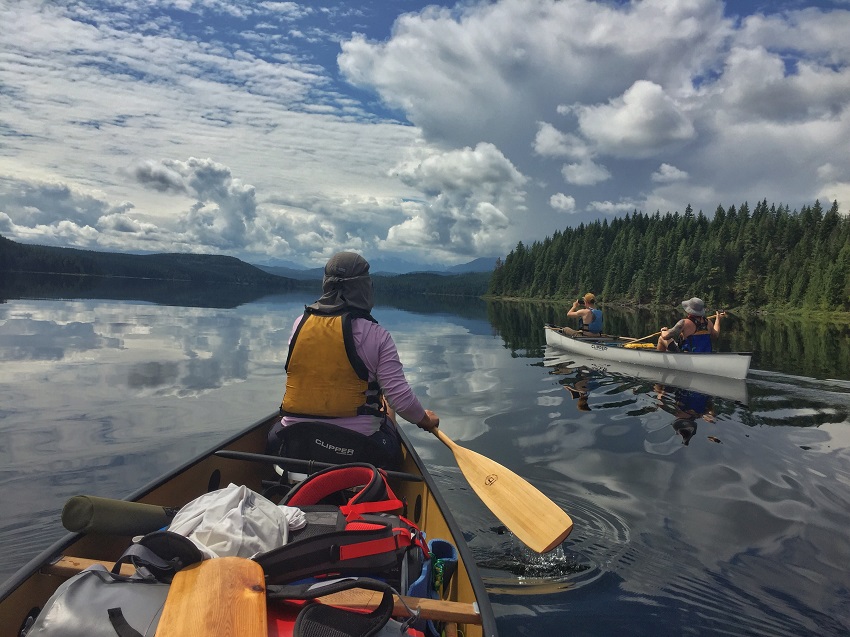
Comfort and Safety
The most important factor to consider when you load your canoe is your safety. You should be able to safely exit your fully loaded canoe in the event of a capsize, or when you reach the shore. Don’t load gear onto yourself, or jam yourself in with bags and barrels.
Make sure you’re comfortable, too. Too much equipment can stop you from stretching out or can push you into uncomfortable positions. You need to be able to paddle for hours at a time and you can’t do that with a barrel digging into your ribs.
Trim and Balance
Aim to keep the weight neutral when you load up your canoe. Affecting the trim – the forward/backward balance of the canoe – can make it hard to control your boat, or to paddle against the wind. A side-to-side imbalance makes it harder to control your canoe and more likely that you will tip, and you can find yourself having to counterbalance your gear with your body weight.
Storing Gear in a Canoe: Tied, tethered, or loose?
In calm water environments, it’s often okay to simply load up your equipment into your canoe and head off. Unsecured gear will fall out of your canoe in the event of a capsize, but in calm water that makes it easy to rescue the canoe and collect up the gear afterward. By having your gear loose, it’s easy to access at all times and there’s no time wasted tying and untying your bags every time you stop.
A step above loose gear is tethering, using a long piece of rope to attach your bag to your canoe. With single bags or barrels, this can be a simple way to ensure your gear remains with the canoe if you capsize, and has the bonus that it can be moved around to help affect the trim if you’re paddling in the wind. With more than one bag though, you can end up with too much rope and this can be dangerous, causing entanglement issues that are especially dangerous in moving water.
In white water or strong winds, it’s advisable to lash your gear down securely in your canoe to prevent it from going anywhere if you capsize. In these environments, a bag or barrel going overboard may be unretrievable and you could lose the items stored inside. The lashed gear will also provide extra buoyancy in the canoe and make it easier to rescue, as it will fill with less water.
Stay Safe on the Water
Don’t set off too fast
You’re most likely going to be canoeing for hours, covering miles on the water. If you set off too fast there’s a good chance of burning out or injuring yourself. Think of the first hour as a warm-up and start gently where possible. If you don’t have that option and have to immediately paddle against a fierce wind, or in rapids, consider warming up before you get on the water.
Keep the Group Together
If you’re paddling with other canoes on your camping trip, it’s useful to keep everyone within a reasonable distance of each other. That way, you can make decisions together, eat together, and if someone capsizes you are on hand to rescue each other. You often find yourself staying closer together in wilder conditions, and spreading further apart when the weather is calm.
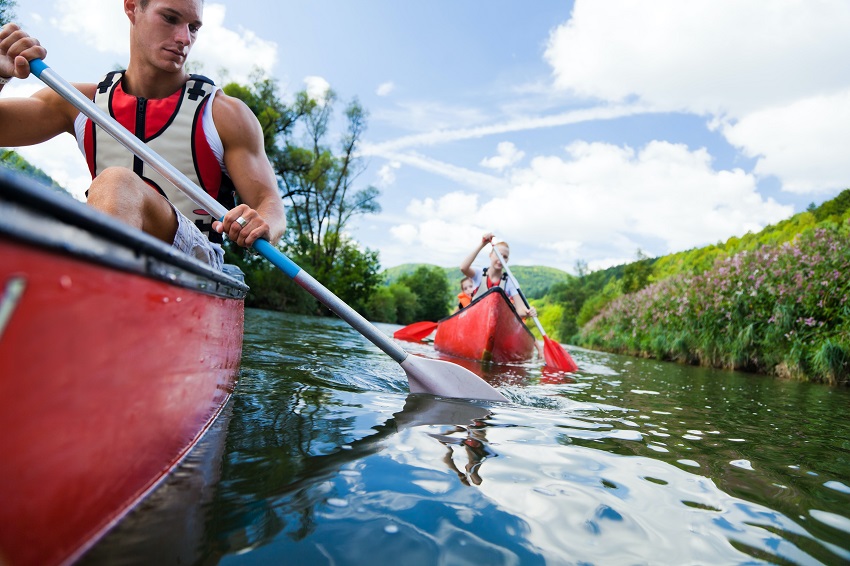
Finding a Campspot
The canoeing is only a part of the trip and eventually, your day is going to come to an end. When you reach your camp spot, there are important factors to consider before firing up the stove and getting comfortable.
Location Location Location
Try to find a flat area near the water’s edge if you’re sleeping in a tent or a thicket of trees for hammock campers. Avoid pitching your tent in a dip in the ground, as these will fill with water if it rains. Look for shelter against strong winds, or an open spot if you need a breeze in calmer weather, to keep the bugs away.
Avoid camping on private ground, and try to be discreet when you’re near civilization to avoid unwanted attention. A flowing stream is useful for drinking and cooking water, but unless you’re sure it’s safe to drink you should still treat it to avoid illnesses.
Tides or Rising Water
Before you set your pitch up, is the water level going to change overnight? Tides, heavy rain, or an upstream dam that could release water can all cause sudden changes in the water levels of lakes and rivers. Be aware of these to avoid being woken up by water lapping over your toes in the early hours of the morning.
Wildlife
Part of getting back to nature is making sure you keep yourself and your food safe from inquisitive creatures and critters. Bugs are a menace, but easy to deal with through bug spray and nets. A hungry bear, however, can cause far greater problems.
Keep your food secured in airtight containers in bear country and consider hanging a bear bag to keep your food out of reach. Do not take any food or food items into your tent overnight, and make sure you have tidied your campsite before you go to bed.
Top Tip: Secure your Canoe

A quick hitch around a tree with your painter can be the difference between waking up in the morning to still having a canoe, or being up the creek without more than just a paddle. This is especially important if water levels are likely to rise, or in strong winds.
Leave No Trace
Perhaps the number one reason for canoe camping is to get back into nature and reconnect with the natural environment. As responsible canoe campers, you should endeavor to leave as little trace behind you as possible. This means:
- Taking trash home with you,
- Using portage trails where possible,
- Minimizing the impact of campfires and wood collection, as well as following any restrictions or advice,
- Not cutting live wood, but using fallen wood or wood you have brought in,
- Toileting responsibly and disposing of human waste in the right way, following any local guidelines,
- Respecting wildlife and other campers.
These are just some of the ways to be a responsible canoe camper, and you can find out more about responsible camping here.
Successful Canoe Camping: My Personal Top Tips
Here are my personal top tips from over a decade of canoe tripping.
Canoes Make Great Tables
An upturned canoe propped up by logs or barrels makes a great impromptu table for laying out food in the evening. This is especially great if you’re in a larger group. Just remember not to use it as a chopping board, or you might find yourself bailing as you paddle the next day!

In a world full of GPS systems and apps, there’s nothing better than a map and compass for navigation. It doesn’t rely on batteries and it doesn’t stop working if it gets wet – so long as you waterproof your map, of course.
Learning to use a map and compass lets you save battery on your phone for essential calls, which means you won’t be stuck in a tight spot if you run out of charge.
Be Prepared to Sit It Out
Sometimes we have to concede defeat to the elements. It’s not worth taking the risk against nature if conditions get too windy or rough, especially when you’re a long way from help. Be prepared to pitch your tent and spend the day waiting for the weather to calm down, or river levels to drop if they have flashed up. Perhaps pack a deck of cards or a book to pass the time.
Don’t Overload Your Canoe
You hear it all the time, ‘it’s great canoeing, you can just pack everything and don’t have to think.’ It’s true that you can carry a load more in a canoe than you can on your back, but you still have to propel your canoe across the water. What’s more, you might have to haul all of that gear along a portage trail at some point, too.
To keep your canoe performing to its optimal level, don’t overload 70% of the stated capacity. That means that if your canoe’s capacity is 1000 lbs., you should only load up 700 lbs. This includes paddlers, clothing, and all equipment.
Practice Rescues
Before you head out, practice emptying canoes and rescuing those in the water. Make sure you are capable of doing this in whatever environment you are going to head out in. If you’re paddling solo, have a plan to get back into your canoe and get to the shore if you capsize. If someone capsizes on the trip, it’s not a great time to be working out how to perform a rescue.

